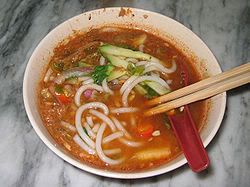
The origin of the name "laksa" is unclear. One theory traces it back to Hindi/Persian lakhshah, referring to a type of vermicelli. It has also been suggested that "laksa" may also be derived from the Chinese word "la sha" (辣沙; pronounced "latsa" in Cantonese), meaning "spicy sand" due to the ground dried prawns which makes the gravy taste extremely sandy. The last theory is that the name laksa is derived from the similar sounding word "dirty" in Hokkien due to its appearance.
Types of laksa
The term laksa is used to describe two different types of noodle soup dishes: curry laksa and assam laksa. Curry laksa refers to noodles served in coconut curry soup, while assam laksa refers to noodles served in sour fish soup. Usually, thick rice noodles also known as laksa noodles are preferred, although thin rice vermicelli (bee hoon or mee hoon) is also common and some variants use other types.
Assam laksa is a sour fish-based soup. Asam (or asam jawa) is the Malay word for tamarind, which is commonly used to give the stock its sour flavor. It is also common to use "asam keping" also known as "asam gelugor", dried slices of tamarind fruit, for added sourness. Modern Malay spelling is asam, though the spelling assam is still frequently used.
The main ingredients for assam laksa include shredded fish, normally kembung fish or mackerel, and finely sliced vegetables including cucumber, onions, red chillis, pineapple, lettuce, common mint, "daun kesum" (Vietnamese mint or laksa mint) and pink bunga kantan (ginger buds). Assam laksa is normally served with either thick rice noodles or thin rice noodles (vermicelli). And topped off with "petis udang" or "hae ko" (蝦羔), a thick sweet prawn/shrimp paste.
I love assam laksa most than other laksa unfortunately I only can give you Penang Laksa recipe's instead.
1.5 kg of fish
10 cups water
12 dried chillies - scalded and left to stand
6 fresh red chillies
thumb-sized piece of mature turmeric
3 stalks of serai
300 gm shallots
200 gm belachan
2 stalks of bunga kantan
8 stalks of daun kesom
1 Tbsp sugar
2 tsp salt
2 cups assam water
1 cucumber
half a pineapple
1 big onion
1 bunch mint leaves
1 stalk lettuce
2 sweet pickled cucumber
laksa noodles
Preparation:
The items c) to g) are finely ground; using only 3 of the red chillies for grinding, as the other 3 chillies are sliced and are for the the garnishment, while the fish is deboned after cooking.
The "bunga kantan" and the "daum kesum" are thinly sliced; use only one of the "bunga kantan" for the gravy; the other is meant for the garnishment.
for the gravy -
Bring water to the boil and cook fish. Debone fish and return fish bones to the stock and simmer for 20 to 30 minutes, then strain the stock. Add ground ingrediants to the stock and boil with one bunga kantan and the daum kesum. Simmer for 20 more minutes. Add the deboned and shredded fish and the assam water, and season to taste.
for the vegetable garnishment -
Except for the mint leaves which are washed and destalked, slice or shred all the items from n) to s) plus 3 red chilles and the bungah kantan. Arrange the vegetables in separate containers at the table.
for the toppings -
1 bowl "haeko" (black prawn paste) mixed with water to flowing consistency
To Serve: Place the laksa noodles in a bowl. Top them with your choice of sliced or shredded vegetable garnishment, then ladle simmering gravy over the noodles. Add a spoonful of "haeko".
Makes 10 to 15 portions ("party sized")
Taken from : Delaksa



0 comments:
Post a Comment